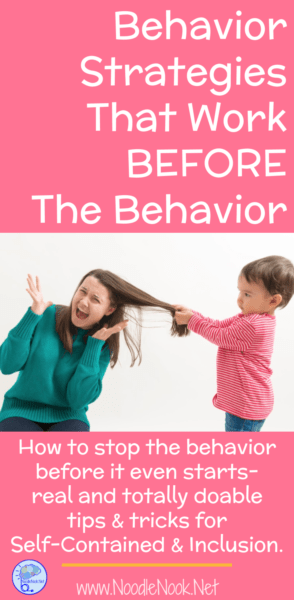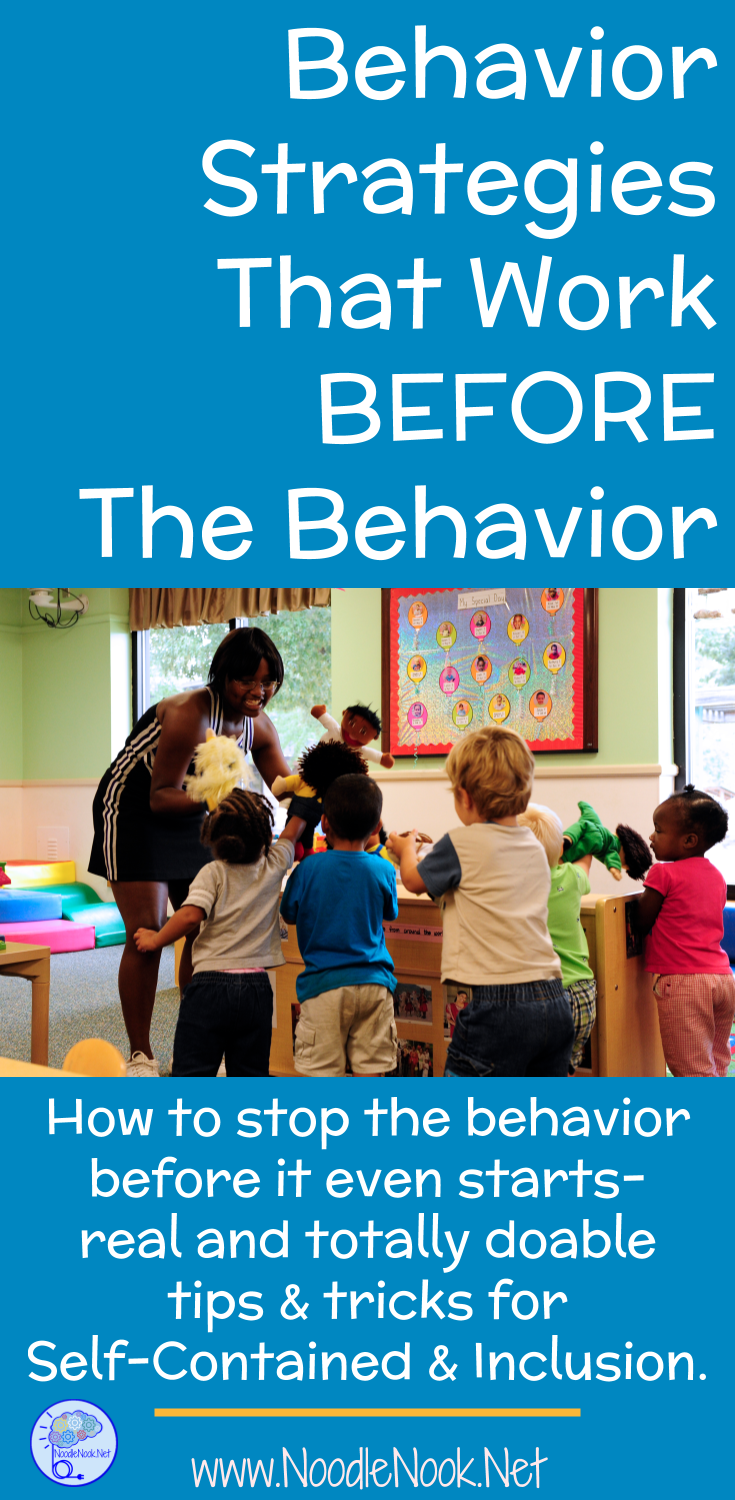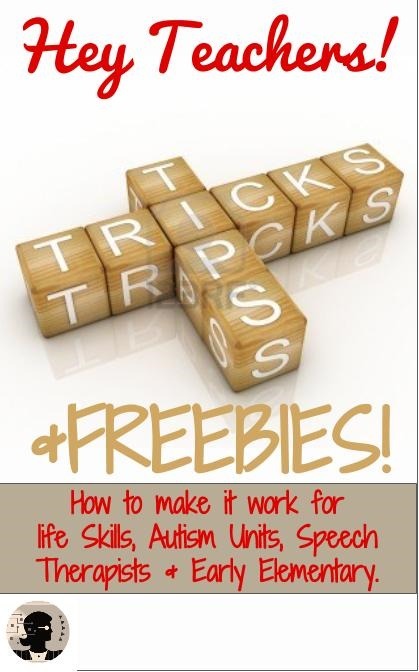It’s Going to be One Of Those Days…
I used to have a student and, I swear, I knew if we were going to have a spitting, hitting, biting kinda day the way his foot landed on the pavement when he got off the bus. Have you ever had one of those days where you knew it was going to be awful two minutes into the school day? I totally understand… so here’s a list of behavior strategies that work!
Behavior Strategies that Work BEFORE the Behavior
I know you can see it coming… there may be some stimming, humming, pacing, vocalizations or a combination of all of the above. The thing is you know.
And you so don’t want to go there.
So what can you do to stop a behavior before it even gets started? The first then you need to do is recognize. If you don’t see the behavior coming, you’ll never be able to effectively intervene. It may not be you that’s having a problem seeing the Behavior coming. You may be working with support staff or related services providers who come into the classroom and set everything off. It’s important not only for you to recognize the chain of events that lead to bad behavior, but it’s equally as important that those helping you also see it coming.
So how do you get everyone on the same page? Meet! Send an email to those not in the classroom all the time like related services. It may be you develop a code word to help your paraeducators recognize if they are struggling. “It looks like rain” may be all you need to say to queue your classroom support people the behavior is coming and to use these strategies.
Either way, you will not be able to use the great strategies below if you can’t see the behavior coming.
Behavior Strategies that Work: WAIT TIME!
Have you ever been on the edge and had someone ask you a question, any question, and you just want to burst? As a mother and grandmother, I can tell you this has happened to me more than once… like I don’t have the patience for a single demand by the time I get home from working with special needs students with behaviors all day. I know you feel me when I say that.
You and I have the benefit of having some better coping skills and calming sequences than most of our students… and if WE benefit from extra time you know our students do too.
Wait. Just an extra 20-30 seconds for a student to process, push through the negativity, and get a response out really helps. What doesn’t help is repeating the question or directive over and over- it will just feel like nagging and may push a kid over the edge.
So just wait.
And be sure to share with your paraeducators and aides what an appropriate wait time is for a student. Even practice so they can feel how much time is enough. And read this post about Cookie Monster and Wait Time.
[tweetthis]Behavior Strategies that Work BEFORE the Behavior- Inclusion and Self Contained![/tweetthis]
Behavior Strategies that Work: Requesting a Break
Lord knows sometimes I need a break. And I know how to ask for one. Does your student know how? They really do have to. Knowing how to request a break, knowing what happens during break, and how/when the break ends is an essential part of breaking the bad behavior cycle for a student with Autism.
Determine how a student will ask for a break (and add a visual to cue break time). Next decide what is available to a student when they are on break (like head down, puzzle, writing/drawing, play-doh, etc.). Then figure out how long break will last and how time will be measured- will it be a timer? Or maybe the time it takes to watch a video? Either way, breaks are timed. Finally, how does a student return to work. I know this is a weird question, but does the student return to the work they were doing before the break? Is there a preferred activity used in the transition? Is there a low-difficulty academic task used to transition? You have to decide how to transition back to work or slowly get back to the routine.
We have just added a printable pack of behavior visuals to the store, if you need more visuals in your classroom, including break cards, rule cards, and work icons, then check it out here.
Special Note: If a student initiates a break, you must let them have it! If you don’t, it may make the process unmeaningful to the student and work against you. Try not to refuse a properly initiated break request.
Behavior Strategies that Work: Lighten the Load
Frustrations can run high when a student is on edge and a behavior is coming… so lower the load. If a student is supposed to complete three problems before they get a break in a first-next-then work cycle make sure those problems are easier or shorter. Get through the routine faster and with less effort.
Behavior Strategies that Work: Add Physical Activity
Finland is consistently ahead of the academic pack when we compare test scores and student performance globally. Know what? They have recess all the way through high school. They don’t call it recess, but each hour students and teachers get a 15 minute break for physical activity and social interactions. Wow.
At many campuses I work with, I see students only have a real “break” between class periods for about 5-7 minutes. And teachers, worried about transitions with a student who needs lots of structure, make the student stay in their space or seat through that time. So where is the physical activity? There is none… until they start beating the heck out of us adults.
So how can you work that out? Try a walk. Worried about students leaving class? Try sit ups or push ups in the room. Want a student to stay in their chair? Try chair knee ups or arm curls. The point it ANYTHING to move becomes important.
If you are working with slightly younger groups, try brain breaks. Play the Madagascar theme song and encourage students to dance, jump, wiggle or just seat shuffle. Studies show having physical activities incorporated into the classroom actually helps students with retention and skill development. What do you have to lose?
Behavior Strategies that Work: Review the Schedule
Sometimes students have anxiety about being at school. If at all possible, review the schedule for the day. It may even be you have to review the schedule for a particular class or a specific activity.
The goal is help a student anticipate what is coming so they can better manage in the moment.
Think about how you feel at a staff development or when you’re called into a meeting. Doesn’t it feel like if you knew what was coming you’d be less anxious about the whole thing? Like if you knew the agenda you could handle anything?
Same thing with our students, knowing the expectations and what is coming in the next 5 minutes, the next 10 minutes, or even for the entire day may help to alleviate the anxiety and you might find that it cuts off the path to bad behavior.
Behavior Strategies that Work: Offer Choice
In a prior post we shared that the average adult makes Over 35,000 choices in a single day. The problem for some of our students, especially those with severe disabilities, is that we’ve systematically removed opportunities to make even basis choices throughout the day.
Statistics say I will make over decisions today about what I eat. Over 200! Yet a student may just have a choice from two at breakfast, 2-5 choices of items at lunch, and then no choice at dinner. With so little choice, it’s easy to understand how someone may become frustrated.
Offering multiple opportunities for choice, even if the choice is from two activities that are required for the day, can really add to a person’s overall self-esteem and the feeling of self-determination. And be sure to offer choice to nonverbal or semi-verbal students too- they have opinions, feelings, and preferences!
I used to have a student who was VERY defiant, and whenever I asked her what she wanted to do she got defiant. When I told her what she needed to do, she resisted and got physical. This was before I developed a better skill set when working with students with ODD and Autism. Even if her choices were between two tasks I picked out, offering her the opportunity to choose which one she wanted to do made a dramatic change in her daily behavior.
It was like night and day.
So I encourage you, as many times as possible, to offer your students choice.
Behavior Strategies that Work BEFORE the Behavior
Just to recap:
- Add Wait Time
- Model How to Request a Break
- Lighten the Workload
- Engage in Physical Activity
- Review the Schedule
- Offer Choice
I can guarantee that adding these things BEFORE a student engages in bad behavior, but at the point where you can see the cycle of behavior starting makes a HUGE difference. Use these strategies, but also teach your support staff and para-educators to recognize a behavior chain is starting and how to use these strategies too.
What other things work for you when you see a behavior coming?
Share in the comments and be sure to pin, post, tweet, and share this post so others have more tools in their behavior tool belt!
Article Citation: [cite]





